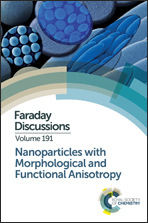From near hard spheres to colloidal surfboards
Abstract
This work revisits the synthesis of the colloidal particles most commonly used for making model near hard suspensions or as building blocks of model colloidal gels, i.e. sterically stabilised poly(methyl methacrylate) (PMMA) particles. The synthesis of these particles is notoriously hard to control and generally the problems are ascribed to the difficulty in synthesising the graft stabiliser (PMMA-g-PHSA). In the present work, it is shown that for improving the reliability of the synthesis as a whole, control over the polycondensation of the 12-polyhydroxystearic acid is the key. By changing the catalyst and performing the polycondensation in the melt, the chain length of the 12-polyhydroxystearic acid is better controlled, as confirmed by 1H-NMR spectroscopy. Control over the graft copolymer now enables us to make small variations of near hard sphere colloids, for example spherical PMMA particles with essentially the same core size and different stabilising layer thicknesses can now be readily produced, imparting controlled particle softness. The PMMA spheres can be further employed to create, in gram scale quantities, colloidal building blocks having geometrical and/or chemical anisotropy by using a range of mechanical deformation methods. The versatility of the latter methods is demonstrated for polystyrene latex particles as well.
- This article is part of the themed collection: Nanoparticles with Morphological and Functional Anisotropy

 Please wait while we load your content...
Please wait while we load your content...